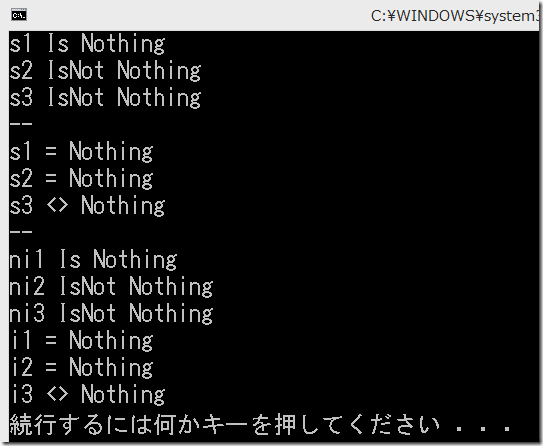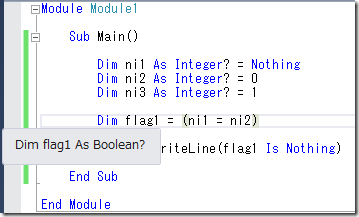まとまるかどうかはさておき、VB.NETでのお仕事がひと段落したので、個人的に気になった点ベスト5をば。
第5位 Char
C#ではCharは数値状態で扱えますが、VB.NETでは一文字として扱います。
なお、Charの配列はStringと暗黙的に変換します。
第4位 配列
これはVB6時代の負の遺産を引きずってる筆頭だと思うのですが、配列の宣言が異なりますよ。
まぁ、要素数を指定して配列を定義することはあまりないですけどね。
第3位 自動実装プロパティー
VB.NETでは自動実装プロパティーのバッキングフィールドにアクセスできるんですね。
Propertyでは、「_」から始まるフィールドが、Eventでは「Event」が末尾についたデリゲートが自動生成され、プログラム中からアクセスが可能です。
# あっ、Eventは自動実装プロパティーじゃないや
Public Class Class1
Public Property Property1 As String
Public Event MyEvent As EventHandler
Public Sub Method1()
Me.Property1 = "aa"
Me._Property1 = "bb"
RaiseEvent MyEvent(Me, EventArgs.Empty)
Dim a = MyEventEvent
End Sub
End Class
第2位 Nothing
NothingはC#でいうところのdefault(T)に当たります。なので、
Dim i As Integer = Nothing
みたいな宣言も可能です。あと、難しいのは比較。= Nothingだったり、Is Nothingだったりですね。空文字列=NothingがTrueになるのはよくわかりません。
Module Module1
Sub Main()
Dim s1 As String = Nothing
Dim s2 As String = String.Empty
Dim s3 As String = "abc"
If s1 Is Nothing Then
Console.WriteLine("s1 Is Nothing")
Else
Console.WriteLine("s1 IsNot Nothing")
End If
If s2 Is Nothing Then
Console.WriteLine("s2 Is Nothing")
Else
Console.WriteLine("s2 IsNot Nothing")
End If
If s3 Is Nothing Then
Console.WriteLine("s3 Is Nothing")
Else
Console.WriteLine("s3 IsNot Nothing")
End If
Console.WriteLine("--")
If s1 = Nothing Then
Console.WriteLine("s1 = Nothing")
Else
Console.WriteLine("s1 <> Nothing")
End If
If s2 = Nothing Then
Console.WriteLine("s2 = Nothing")
Else
Console.WriteLine("s2 <> Nothing")
End If
If s3 = Nothing Then
Console.WriteLine("s3 = Nothing")
Else
Console.WriteLine("s3 <> Nothing")
End If
Console.WriteLine("--")
Dim ni1 As Integer? = Nothing
Dim ni2 As Integer? = 0
Dim ni3 As Integer? = 123
If ni1 Is Nothing Then
Console.WriteLine("ni1 Is Nothing")
Else
Console.WriteLine("ni1 IsNot Nothing")
End If
If ni2 Is Nothing Then
Console.WriteLine("ni2 Is Nothing")
Else
Console.WriteLine("ni2 IsNot Nothing")
End If
If ni3 Is Nothing Then
Console.WriteLine("ni3 Is Nothing")
Else
Console.WriteLine("ni3 IsNot Nothing")
End If
Dim i1 As Integer = Nothing
Dim i2 As Integer = 0
Dim i3 As Integer = 123
If i1 = Nothing Then
Console.WriteLine("i1 = Nothing")
Else
Console.WriteLine("i1 <> Nothing")
End If
If i2 = Nothing Then
Console.WriteLine("i2 = Nothing")
Else
Console.WriteLine("i2 <> Nothing")
End If
If i3 = Nothing Then
Console.WriteLine("i3 = Nothing")
Else
Console.WriteLine("i3 <> Nothing")
End If
End Sub
End Module
結果
第1位 3値論理
SQLとかでよくあるやつですね。VB.NETではNull許可型同士の比較はBooleanではなく、Boolean?型になります。これ、Nullable型の時だけなんですよね。なぜ?って感じ。
Module Module1
Sub Main()
Dim ni1 As Integer? = Nothing
Dim ni2 As Integer? = 0
Dim ni3 As Integer? = 1
Dim flag1 = (ni1 = ni2)
Console.WriteLine(flag1 Is Nothing)
End Sub
End Module



コメントを残す